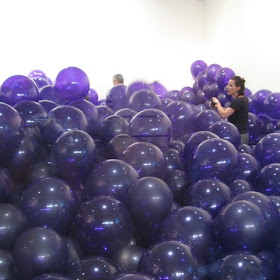When I wrote about the current exhibition on at GoMA Brisbane I didn’t dream that the galleries would be under threat and then flooded. I had planned to write a follow-up post on other exhibits on show. Then the floods struck and life was turned upside down. My resolutions of doing something everyday were also scuppered – painting in a house with seven children under seven years old was not feasible. It also seemed slightly frivolous to be trying to paint at a time when so many people had lost their homes and businesses.
But the resilience of people in my new city is uplifting and inspiring. In flooded areas complete strangers arrived armed with their gumboots, shovels gloves and brooms to clear the mud form the city.
So back to the Exhibition 21st Century: Art in the first decade. The artworks in the galleries were moved to the upper levels and none were damaged but the buildings in the Cultural Precinct will be closed for some time.
When the galleries re-open, I am not sure whether the Current exhibitions will be extended or whether future planned events will take their place. Nevertheless, I want to talk a little more about some of the works that I enjoyed during my previous brief visit.
This gallery space was a wonder of colour and texture on a large scale. Viewers are dwarfed by Tayou’s huge brightly coloured assemblage Plastic bags 2001–08 hanging from the ceiling. This assemblage is made of thousands of coloured plastic shopping bags - the use has transformed the ‘throw away’ into something beautiful.

It’s extremely tactile – people kept reaching out to touch. The Gallery attendant was hard pressed to keeping the viewers away form the work. Some were prompted to lie underneath it – as though daring it to break free from the ceiling and envelop them.The Gallery website notes on this work call it: 'an ominous spectacle of consumerism'
Left/Right Side by Carsten Höller is a source of great fun for kids – they can slide from the upper floor of the foyer down to the floor below. The shiny sculptural stainless and polycarbonate shapes sweep the children swiftly downwards.
We usually associate Lego with brightly coloured blocks – the transformation to white makes them recognisable but so different. The cubic structural evolution project 2004 by Olafur Eliasson ran the length of the Lower gallery space. It is a project where children can create an ever changing metropolis using white Lego blocks.
The activity isn’t confined to children however – there were a number of adults as engrossed in construction as the children. As a counter-point running along the adjacent wall was the brightly coloured I wish your wish.
The Bentinck Island artists are a group of very senior female painters of the Kaiadilt people who live on Mornington Island in the Gulf of Carpentaria.
The artists have said: We have painted one of the most important places on Bentinck Island. This is where King Alfred was born. This is his country. King Alfred was Sally's big brother and he was also Netta's father. He was famous as strong warrior and leader, he was feared by other tribes. This place is special to all seven of us. We all have close connection to this country. That is why we picked it as painting for us to do together
You can read the previous post on this exhibition here.
So now I'm moving forward and making another start.Just in case you think I've been completely idle I will be posting what I've been doing soon - no more long delays between posts!





















